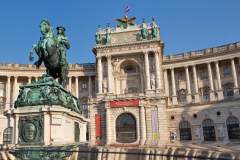Serbian Ball In Vienna Holy Sava Ball
February 2026 | ||||||
|---|---|---|---|---|---|---|
Mo | Tu | We | Th | Fr | Sa | Su |
Serbian Quadrille on the Azure of the Viennese Danube
The crimson magic of the night glowed on the snow, the silver moonlight was icy and smooth, and the stars shimmered with unusual excitement. The trees, black and wet, awakened by the light, moved sideways and waved with pearly fingers. “What’s going on?” the branches rustled sleepily and softly, whispering. Watery, song-loving, timid, and painted cobalt blue in the night, Vienna was ready to welcome the beginning of yet another ball. But this time, a Slavic one.
The most prestigious event of the Serbian community in Vienna and a continuation of a ball tradition from the 19th century.
The history of the Viennese ball tradition dates back to the 17th century and remains closely linked to the city of Vienna. Around 450 balls take place annually in the Austrian capital from November to February, and the St. Sava Ball has been part of this tradition since 1998. What makes it special is the fusion of Serbian and Austrian culture; at the St. Sava Ball, guests dance both waltzes and to the sounds of Serbian violins and trumpets. At the upcoming St. Sava Ball on February 10, 2023, our guests can expect several special features, the most significant being the location – the St. Sava Ball will be held in the Vienna Hofburg for the first time.
The program of the St. Sava Ball comprises numerous musical highlights and other artistic performances. With food and drink and the unique backdrop of the Vienna Hofburg, all the senses of the ball guests are guaranteed to be engaged.
7:00 PM: Arrival of guests (entrance Heldenplatz) with musical accompaniment
Program in the ballroom
21:00
Formal opening of the ball in the ballroom
22:00
“Alles Walzer” in the ballroom
22:30
Music program
00:00
“Serbian Quadrille” & Kolo – Public Quadrille: All guests are invited to dance
00:40
Handover of the charity check to the Dobrić family
01:00
Midnight performance
02:00
Music program
02:45
Final Kolo – Public Kolo: All guests are invited to dance
03:00
End of the program in the ballroom
Program in the other halls
20:30
forum
21:30
Agape Hall
21:45
Ceremonial Hall
22:00
Knights' Hall
22:00
Hofburg Salon (Campari Bar)
03:00
Ball end
Dress Code
A ball is a complete experience, encompassing not only dancing, music, a special ambiance, food and drink, but also appropriate attire. The Sava Ball is meant to be something special for you, an unforgettable escape into another world. To ensure this, it is essential that every single guest adheres to our dress code.
Ladies: Floor-length evening dress (no short skirts and dresses, cocktail dresses, trouser suits, traditional costumes; slit allowed)
Men: Tailcoat, tuxedo, formal uniform, dark suit with bow tie (no necktie, no traditional dress)
Anyone violating the dress code will be refused entry to the ball, even with a valid ticket. Refunds for tickets and seat reservations lost due to non-compliance are not possible.
Program and cast
Vienna Hofburg Kongreszentrum
The Kaiserball developed from the imperial tradition of the so called “Hofball” (court ball) and “Ball bei Hof” that were organized by the imperial couple Franz Joseph (1830–1916) and his wife Empress Elisabeth (1837–1898), who is better known as Sisi. Both ball events were taking place in the Hofburg being the imperial winter residence of the Habsburg family.
The Hofball used to take place towards the end of January, with Empress Elisabeth deciding the precise date. Once the court had gathered in the Zeremoniensaal - which is still one of the most stunning rooms at the Hofburg to this day- selected guests were invited to pay their respects to the Emperor and Empress in person. The popular buffet was set up in the nearby Grosser Redoutensaal. Meanwhile the dance floor was positively brimming with activity - after all some 2,000 ballgoers were in attendance. The last waltz commenced at exactly quarter past midnight, and drew this spectacular imperial event to an end.
The “Ball bei Hof” took place just two weeks later. This more intimate event, reserved for the ruling elite, drew around 700 high-ranking royals and members of the diplomatic corps. To qualify as "Hochadel" (higher nobility), aristocrats were required to demonstrate a lineage going back at least eight generations on both the maternal and paternal sides.The most valuable porcelain in the imperial dining service was unpacked for a formal dinner which was served in the Radetzky apartments and neighbouring rooms. The strict seating order was dictated by rank. Ladies spared no expense and took every care to ensure their appearance matched the occasion, happily parting with between 300 and 500 Gulden for an evening dress - more than the annual income of a court servant.

 EN
EN DE
DE IT
IT FR
FR ES
ES RU
RU JP
JP RO
RO
 Seating plan
Seating plan 


